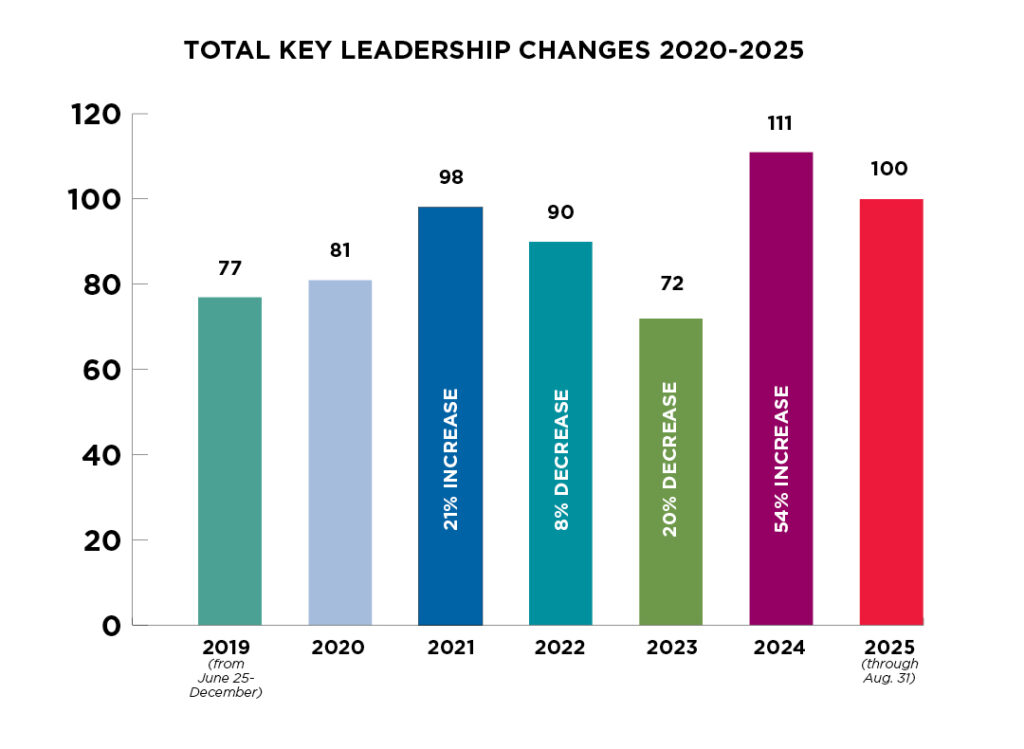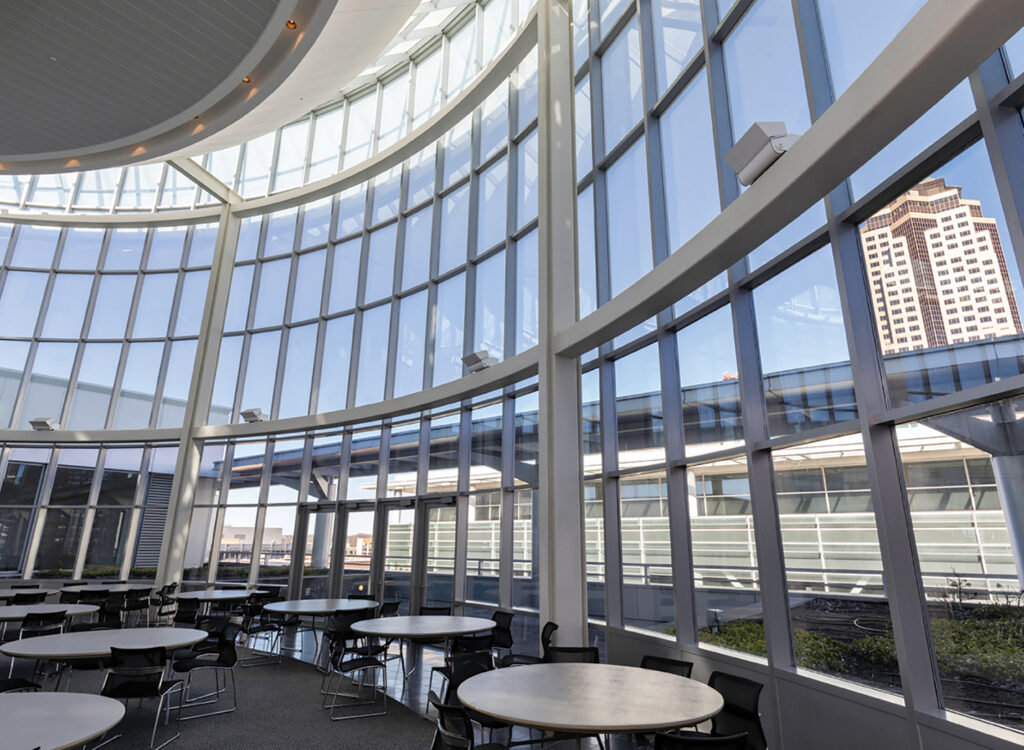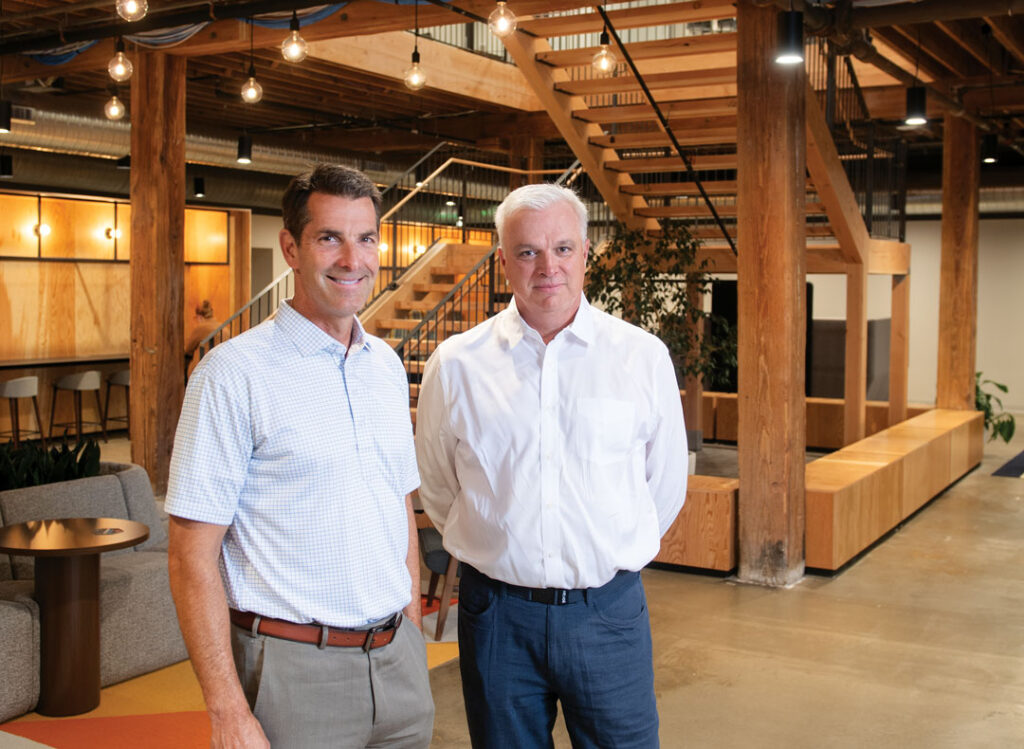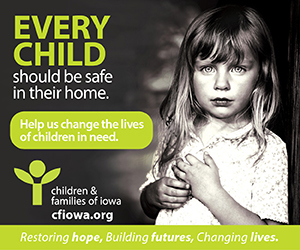The Business of Beer

Nestled comfortably among the corn and soybean fields, the rivers, the small-town main streets and the downtown insurance industry skyscrapers, those who go seeking across Iowa can find one of the 94 craft breweries recorded across the state by the Brewers Association in 2018. Craft beer brought an estimated economic impact of $861 million in 2017, a number that seems likely to grow as more breweries are opened across Iowa.
The Business Record sat down with five expert panelists at the Iowa Taproom — Jeff Bruning, partner at Full Court Press; Mackenzie Nading, executive director at the Iowa Wholesale Beer Distributors Association; J. Wilson, minister of Iowa beer at the Iowa Brewers Guild; John Martin, co-founder and head brewer at Confluence Brewing Co.; and R.J. Tursi, founder and CEO at Exile Brewing Co. — to dive deeply into the business behind brewing and distributing.
On a scale of 1 to 10, where does Iowa’s craft brewing scene fall?
R.J. Tursi: If we’re looking at it in a national context, where you have really large breweries in almost all of the surrounding states like in Missouri, Minnesota, Illinois, Wisconsin especially, Iowa is definitely behind in terms of people drinking craft, overall craft volume being produced. In that context, maybe five, right around four or five, but in the last five to 10 years, I think it’s really, really come a long way.
Jeff Bruning: In the whole scheme of things, the crafted beer industry started, some will say, with Fritz Maytag, an Iowa native, and Anchor Brewing in 1965. He took over an 1896 brewery and kept it alive. In some ways we’re a little behind. Millstream [Brewing Co.] was [opened in] 1985. … But our lag time between that and 2010, other states have really gotten far ahead. I would say, like with R.J., it really is in that adolescent stage, at best. We’re having some growing pains.
Mackenzie Nading: We have many of our beer distributors now who have a craft team, or they have people on staff that are specialized to do the craft accounts. They are the ones doing management of cleaning the lines and marketing, going out trying to find other products to put on the shelves and in the warehouse. … That’s something that just wasn’t around five or six years ago.
What led to Iowa lagging behind?
John Martin: I think being in the middle of the country, we’re always slow to the party. There’s also population — Minnesota, Wisconsin, Missouri all have way larger populations than Iowa. So I think it’s being supported by the population center.
Bruning: I think we’re also an older state, and older people tend to drink less beer. A place like Colorado and California, Oregon, Michigan, they have a natural draw to some younger folks. … It’s easier to gain more craft beer drinkers.
When [brewers] can’t come to the state because half your portfolio can’t come to the state [pre-]2010*, you don’t really want to come. There was a time there in the last five years where a lot of craft breweries were talking about coming to the state of Iowa because they hadn’t.
J. Wilson: Nowadays, I don’t think a brewery from California or Colorado or Michigan can just count on bringing beer to Iowa and have it fly off the shelves naturally. If there’s a good Des Moines IPA from Confluence, then I’m going to drink that first.
Nading: When you consider bringing on a portfolio to a large warehouse, you want it to sell. So there’s a lot of conversation back and forth with the manufacturer about, what is your brand? Where are you selling? How are you going to make this beer something that consumers are looking for? In at least the last 10 years, what consumers are looking for is who made your beer. If you can walk down the street and point to John, who you know is the one that’s making it, that matters.
Wilson: Beyond retail opportunities, the hop industry is slowly percolating along there; at least two people I know are working to bring malting facilities to the state. There are all sorts of auxiliary industries that are popping up, and if we didn’t have some success in these last few years, then a lot of that stuff wouldn’t really be happening. It just wouldn’t make business sense.
Is anyone measuring growth in Iowa breweries?
Wilson: We’re definitely keeping track of that. We’re around 93 or 94 breweries in the state right now. I don’t think [that] the number of breweries is quite as big a deal.
Anytime somebody closes, people are like ‘Oh gee, are we saturated? Is there too many breweries in Iowa?’ No, not necessarily. The apex of Iowa brewery count was 149 in the 1800s … at like a million [people in state]. We’re around 3 million people now and only the ‘measly’ 94 [breweries]. I don’t care about the number 94 — [Exile] has got a 30-barrel system, pretty wide reach, lots of fermentation space. Toppling Goliath’s [got] a 100-barrel system, a lot wider reach, you know, but there are other people that are one-barrel or two-barrel or three-barrel systems — a barrel being 31 gallons.
Bruning: There’s a lot of people that drink beer that don’t drink craft. To me, that’s the biggest window. I come from Carroll, Iowa, and Carroll has a population of 10,000. … Busch Light is the biggest selling beer in Iowa — they consume, I think, 171,000 cases of Busch Light in Carroll. … Just a small percentage of those people would put every brewery in the state to capacity. There’s a lot of opportunities there.
Has brewing become more sophisticated, and is that creating challenges for new breweries?
Martin: Our quality has definitely gone up. … Having a lab, ours is pretty modest but we do yeast counting and do work on microbiological stuff to make sure our beer is clean. That type of stuff, you can open with it if you have the budget, if you have the means.
Having good beer is one thing, but having a good process is another good thing … I see a lot of breweries opening; I’m just super impressed with what they’re doing. It’s crazy. They come to the game ready to play.
Tursi: Opening up, you can create a sensory program at your brewery if you just put the time and the effort into it. It really doesn’t cost much — it costs you time and effort on that type of stuff. You can do that, opening up as a new brewery with not very sophisticated equipment. If you keep your reach small, you can always know how your beer’s doing, what your beer’s doing.
Wilson: [The Brewers Guild] has also started to do sensory programming, flavor education. … We’ve also started to do some line-cleaning seminars as well. John can work his tail off to have excellent beer, and as soon as it ships out his warehouse door, then it’s out of his hands. … If it goes to a bar that doesn’t do a really good job of cleaning the lines, and his really delicious beer goes through filthy, dirty lines, then it’s going to taste sour, dirtier.
I’ve been to breweries and tasted poor beer at a brewery, and it was really a line cleaning incident.
Nading: Manufacturers bestow a lot of trust into wholesalers when they are giving them that product to make sure that when it gets to a line or when it gets to a shelf, that it is treated in every way that it needs to so the customer has a positive experience. We don’t take that lightly with any of the product that we have.
Who are the leaders representing Iowa?
Bruning: I just so happened to look last night, Top 50 Beers in America on Rate Beer, and Toppling Goliath is listed three or four times. [Editor’s note: Toppling Goliath beers on the list as of May 3 are No. 1 Kentucky Brunch, No. 4 Mornin’ Delight and No. 26 Assassin.]
You’re sending stuff way out there and hoping that it does well. … There’s a lot of considerations you have to think about before you start moving out of your area of safety or comfort.
Tursi: We’re only distributed in the state of Iowa, so honestly, we’re more concerned with making sure that we’re recognized by our fans in Iowa. At the national level, yes, we’re entering our beers in national competitions. … Hopefully that gives Iowans more pride in the products that are being produced here in Iowa, and the quality of the product here in Iowa.
Bruning: The [Larry Gatlin quote] I think about almost every day is that he wished somebody would have told him that the “music business” was two words. They had the music thing down, but the business part, they had no idea. … You can be good at the things you’re good at, but if you’re not good at business, the one-barrel brewery or the hundred-barrel brewery can go out of business really quickly.
We see the growth of Iowa breweries. Financially, is the industry figuring out the business angle?
Nading: Simply because our warehouses are seeing a more robust portfolio of craft products is an indicator that people are figuring it out. We care about smart business models when we bring products in. The beer needs to sell. We can do a lot, but the beer itself needs to have branding, it needs to be good, it needs to have a reputation.
Tursi: There’s a constant battle that I’m sure goes on at just about every brewery that has seen some success, between the people in the finance department, people in the sales and marketing department, and people in the production department. … Just trying to toe all three of those lines and walk down that path where all of those things intersect is the balance that we’re trying to strike.
Wilson: It’s interesting to see those guys that have been around for 20, 25, 30 years and see those guys navigate staying relevant just staying relevant in this new crazy time. … I think that’s a real business challenge.
Is the labor market a concern for craft brewing?
Martin: Our labor force has stayed pretty consistent in the last couple of years. We’ve grown to 30-plus employees in the summer, maybe 35 or so. … Twenty of those are full-time, which is pretty awesome. I think we’re doing our part to support the community.
Tursi: Behind the bar is where you might have some turnover. … What we’ve tried to do on the brewery side of things to maybe mitigate some of those labor problems is to always invest in technology, so that if there are some of these remedial jobs that people get super burned-out doing, can we have a machine doing this thing?
Nading: You’ll hear the jargon ‘three-tier system’ thrown out a lot when you talk about this industry. That simply means there are three tiers involved with alcohol production here — specifically, manufacturing, wholesaling, retailing.
At its most basic principle level, it was written in a way that said you cannot cross tiers. You cannot be in one tier and then also have any kind of interest in another. That has changed significantly over time … but one thing that previous to this past year remained was that if you were an employee of one tier, you couldn’t technically also be employed by another tier. … We would have part-time truck drivers that would like to moonlight and bartend somewhere, and that was technically not allowed under the law, and the Alcoholic Beverages Division was going to start enforcing that strictly. A provision was put in place that said if you are not in any kind of significant ownership of a tier, you can work in more than one.
I think that there was probably a lot of people probably violating that provision that didn’t even realize it. It’s important, when we start moving into this industry and everyone’s expanding, that you’ve got to adapt to these kinds of changes.
How was the three-tier system model introduced, and has it been effective?
[Editor’s note: Operators can take part in up to two of the three tiers: brewing, distributing and retailing].
Bruning: It’s because of Prohibition and the Volstead Act back in the 1920s, when they made, for 13 years, alcohol mostly illegal.
When they came back out of it … a Schlitz Brewing Co. could go buy a building, find somebody who wants to run that place. All the way down to the silverware could be branded Schlitz, the sign, the building plaques on the outside facade. … The only thing that the operator has to do is sell Schlitz exclusively.
Fast-forward to when they start pulling these things apart, every state has their own laws and makes their own laws how they want it — the three tier system is a way to guard against that influence from the top down to the bottom. It gives the one-barrel brew system an opportunity in the marketplace that it probably wouldn’t get prior to these laws coming into place.
Wilson: The places where there are stricter three-tier systems, it’s a much less mature market. That 2010 law change (see sidebar page 10) was really helpful in Iowa, and there are other places that are far behind our laws.
Tursi: We got a Special Class A permit, which allows a brewpub privilege. So we are technically a brewpub down at Exile, and as a brewpub, you cannot self-distribute, because then you’re hitting these other Class A licenses. … So unless we’re selling on draft in the taproom or in a growler, everything is going through the distributor. … Even bottles that we sell at Exile, we sell to the distributor, buy back from the distributor, and then sell at Exile.
Nading: You can be a brewpub, just as he described, in which you’re actually a retailer. So you actually have a retail license with the brewing privilege, which is why as a retail account, they must buy their beer, even through a wholesaler, because that’s how every other retailer has to do it.
Or you can be a brewery, which is what Confluence is — a Class A Native brewery — and you can have the right to self-distribute at that point as well. But the caveat is you can only have one on-premise location for the sale of your beer — you can have one taproom.
Martin: We enjoy the privilege of having one retail license and also distributing. You could argue that maybe we could make more money and have multiple taprooms instead of self-distribution, because taprooms are definitely more profitable than just distributing beer. But for now, this is working for us, and we’ve chosen that path.
Bruning: I’m a part owner and investor in my hometown brewery in Carroll Brewing. That wouldn’t have happened if we wouldn’t have gone with the brewpub. … Sometimes it doesn’t make exact sense, but at the end of the day it’s basically to protect each one of the tiers’ opportunities to thrive in the marketplace.
What would you most like people to know about the industry?
Tursi: We fully depend on Iowans drinking craft beer. So anybody who’s listening to this that drinks craft beer, thank you very much. We appreciate it.
If you don’t drink craft beer, give it a try. Give it multiple tries, and find out which ones you like and just start exploring. … If you’re just kind of stuck on what you’ve always drank, you’re really missing a big world that’s out there, and it’s pretty exciting and has a lot of great things to offer.
Wilson: There’s a lot of jobs created from this industry, not just in the breweries themselves but in some of the retail locations. It’s refurbishing neighborhoods … in big cities and small towns alike. Beer tourism is a thing, people are going to drive to Carroll on purpose to taste those beers. … People go all over the state to explore.
Nading: I think there’s some types of rhetoric thrown around that it’s not doing well, liquor and wine is kicking its butt and no one’s drinking beer anymore — you just don’t see that. It may not always be the flashiest thing to talk about, but everyone here at this table cares a great deal about making sure Iowans are consuming responsibly, and also that they’re consuming good products. … We do a lot of good for economic development, we employ a lot of people, we pay a lot of taxes. All of that is just a really positive thing.
Want more beer?
Listen to the full podcast at: businessrecord.com/podcasts










